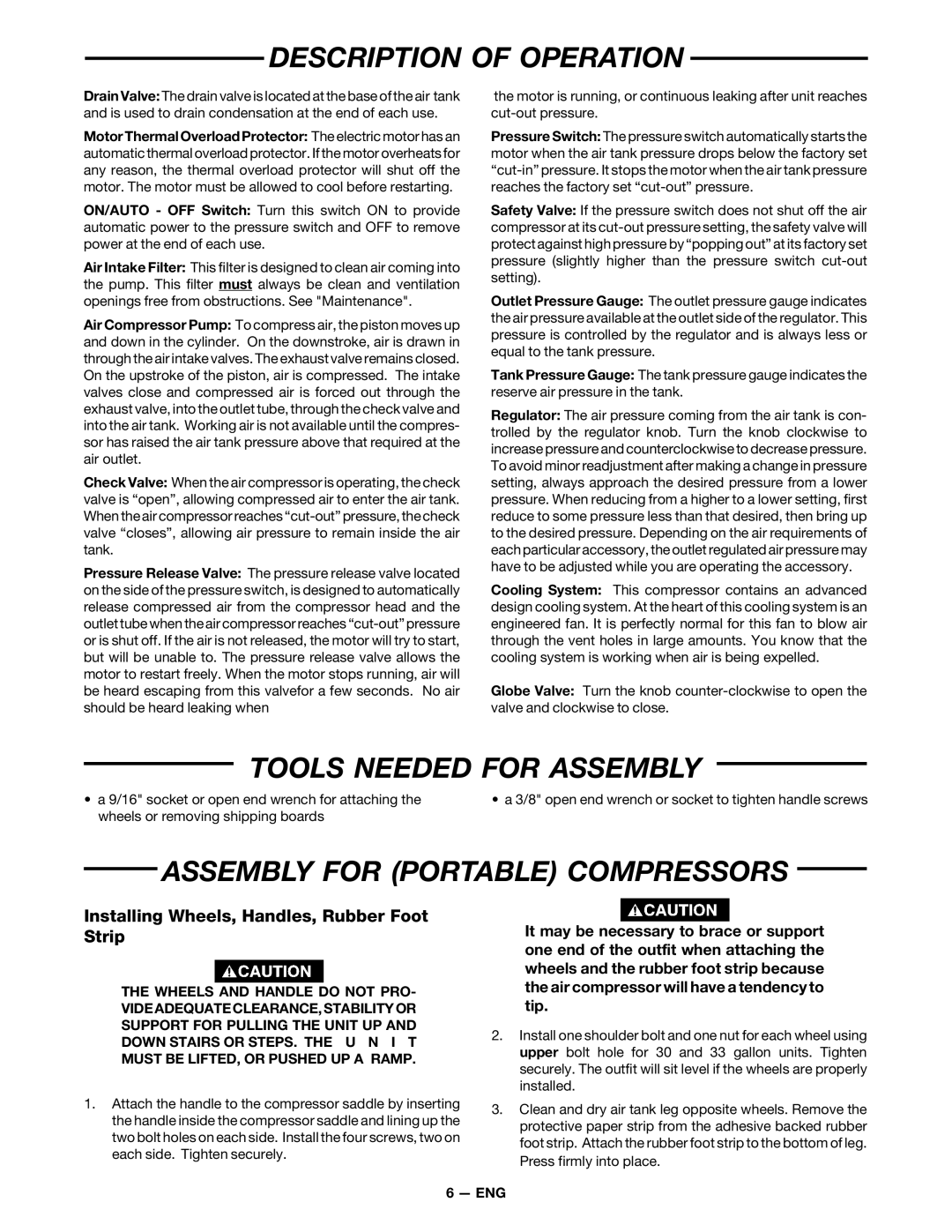
DESCRIPTION OF OPERATION
Drain Valve: The drain valve is located at the base of the air tank and is used to drain condensation at the end of each use.
Motor Thermal Overload Protector: The electric motor has an automatic thermal overload protector. If the motor overheats for any reason, the thermal overload protector will shut off the motor. The motor must be allowed to cool before restarting.
ON/AUTO - OFF Switch: Turn this switch ON to provide automatic power to the pressure switch and OFF to remove power at the end of each use.
Air Intake Filter: This filter is designed to clean air coming into the pump. This filter must always be clean and ventilation openings free from obstructions. See "Maintenance".
Air Compressor Pump: To compress air, the piston moves up and down in the cylinder. On the downstroke, air is drawn in through the air intake valves. The exhaust valve remains closed. On the upstroke of the piston, air is compressed. The intake valves close and compressed air is forced out through the exhaust valve, into the outlet tube, through the check valve and into the air tank. Working air is not available until the compres- sor has raised the air tank pressure above that required at the air outlet.
Check Valve: When the air compressor is operating, the check valve is “open”, allowing compressed air to enter the air tank. When the air compressor reaches
Pressure Release Valve: The pressure release valve located on the side of the pressure switch, is designed to automatically release compressed air from the compressor head and the outlet tube when the air compressor reaches
the motor is running, or continuous leaking after unit reaches
Pressure Switch: The pressure switch automatically starts the motor when the air tank pressure drops below the factory set
Safety Valve: If the pressure switch does not shut off the air compressor at its
Outlet Pressure Gauge: The outlet pressure gauge indicates the air pressure available at the outlet side of the regulator. This pressure is controlled by the regulator and is always less or equal to the tank pressure.
Tank Pressure Gauge: The tank pressure gauge indicates the reserve air pressure in the tank.
Regulator: The air pressure coming from the air tank is con- trolled by the regulator knob. Turn the knob clockwise to increase pressure and counterclockwise to decrease pressure. To avoid minor readjustment after making a change in pressure setting, always approach the desired pressure from a lower pressure. When reducing from a higher to a lower setting, first reduce to some pressure less than that desired, then bring up to the desired pressure. Depending on the air requirements of each particular accessory, the outlet regulated air pressure may have to be adjusted while you are operating the accessory.
Cooling System: This compressor contains an advanced design cooling system. At the heart of this cooling system is an engineered fan. It is perfectly normal for this fan to blow air through the vent holes in large amounts. You know that the cooling system is working when air is being expelled.
Globe Valve: Turn the knob
TOOLS NEEDED FOR ASSEMBLY
• a 9/16" socket or open end wrench for attaching the | • a 3/8" open end wrench or socket to tighten handle screws |
wheels or removing shipping boards |
|
ASSEMBLY FOR (PORTABLE) COMPRESSORS
Installing Wheels, Handles, Rubber Foot Strip
THE WHEELS AND HANDLE DO NOT PRO- VIDE ADEQUATE CLEARANCE, STABILITY OR SUPPORT FOR PULLING THE UNIT UP AND DOWN STAIRS OR STEPS. THE U N I T MUST BE LIFTED, OR PUSHED UP A RAMP.
1.Attach the handle to the compressor saddle by inserting the handle inside the compressor saddle and lining up the two bolt holes on each side. Install the four screws, two on each side. Tighten securely.
It may be necessary to brace or support one end of the outfit when attaching the wheels and the rubber foot strip because the air compressor will have a tendency to tip.
2.Install one shoulder bolt and one nut for each wheel using upper bolt hole for 30 and 33 gallon units. Tighten securely. The outfit will sit level if the wheels are properly installed.
3.Clean and dry air tank leg opposite wheels. Remove the protective paper strip from the adhesive backed rubber foot strip. Attach the rubber foot strip to the bottom of leg. Press firmly into place.
6 — ENG
